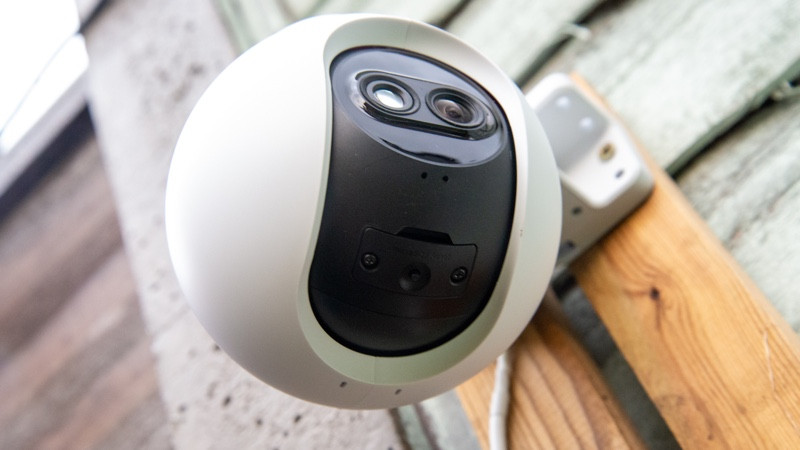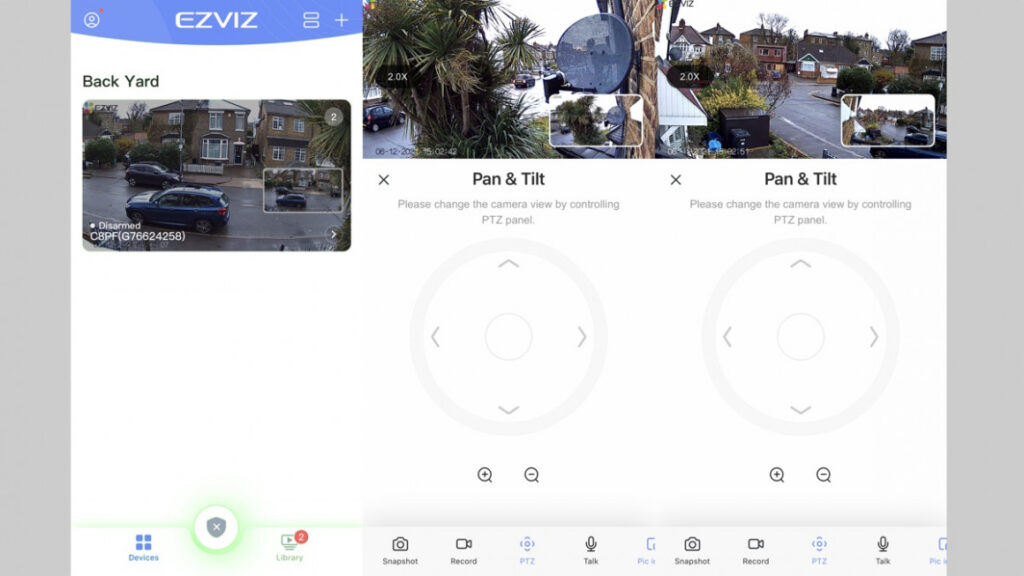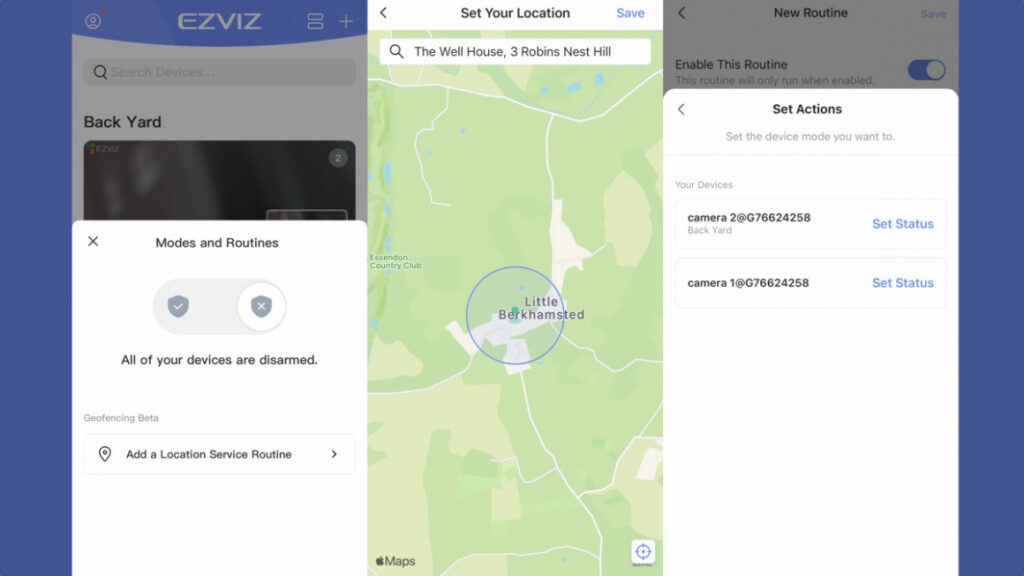See everything with this smart camera
You normally get pan and tilt, or zoom, but not both features in a camera. This combination makes the Ezviz C8PF easy to setup, as you can cover the exact area that you want, and have a look around when you’re away from home. With this camera, it’s more about the details. Without a home position for the camera to return to, it’s hard to configure activity zones accurately. Video quality isn’t the best that we’ve seen, and you can get a 4K static camera for less. If you want the ability to change a security camera’s view when you’re away, then this model is flexible and well priced, but most people will be better off with a static camera instead.
Pros
- Pan and tilt, and zoom all-in-one
- Shoots in wide-angle and zoom mode simultaneously
- No subscription fees required
Cons
- No u2018homeu2019 point
- Video quality is so-so
- Quite chunky
There’s always something that a traditional security camera can’t see, no matter how careful you are installing and focussing the camera.
Not so with the Ezviz C8PF, a motorised pan and tilt camera that you can control from the app. We’ve seen cameras like this before, but this model also has two lenses, one wide and one zoom, giving you even more flexibility.
There’s better overall image quality from the competition, such as the Arlo Pro 4, but if you need the flexibility that this camera offers, it does a good enough job.
Affordable rivals: Best budget smart security cameras
The competition: The best smart home security cameras
At $169, it’s more affordable than the Ezviz BC1, sitting around halfway up the Ezviz line-up. If you’re after a budget option from the brand, check out the likes of the Ezviz CTQ3N or the C6CN.
Ezviz C8PF: Design
The Ezviz C8C was the first pan and tilt camera we’ve seen from the security company, so it’s no surprise that the C8PF doesn’t stray too far from the original’s design. With its ball-shaped body, the C8PF is quite a chunky camera.
In order for the body to move, the camera hangs from the large stand, which can be screwed to a wall or hung from eaves.
Ding dong: Ezviz DB2 review
While this C8PF retains the Wi-Fi connection of the older C8C, here, the antennas are inside the camera’s body, giving a neater finish.

This camera can pan 340-degrees, although the field of view means that you effectively get a full 360-degree view. There’s also an 80-degree tilt, which is a little more restrictive.
When you install the camera, make sure that you place it somewhere that the pan and tilt options let you capture the areas you’re interested in.
Pan and tilt: Ezviz C6 2K review
This camera has two lenses, one wide-angle and one zoom, so not only can you move where the camera is pointing, you can also zoom in close to see what’s going on.
Underneath the camera is a cover for the microSD card slot, which lets you add up to 512GB of offline storage.

Power is via the provided 12V power adaptor, although the connection to the camera isn’t waterproof.
If you’re going to run the power externally, you’ll need to tape the connection closed.

Ezviz does provide a weatherproofing kit for the optional Ethernet connection. Given there’s this port, I’d like to see power over Ethernet as standard, as you get with cameras like the Reolink RLC-811A.
Once powered, you hook the camera up to the Ezviz app, following the wizard to get it connected.
We had a few problems getting our camera to connect to Wi-Fi, to begin with, but rebooting our mesh system solved the problems.
Ezviz C8PF: Features
Open the app and you get a thumbnail view of any cameras that you have installed. Tap the thumbnail for the C8PF and you jump into the live view.
As there are two lenses in the camera, you get a picture-in-picture view, with a thumbnail showing the wide-angle clip and the main picture showing the zoomed-in view, with your choice of 1x, 2x, 4x and 8x zoom.
That’s quite neat, as you can see what’s going on, big picture, but get that detail shot in the main view.
It would be nice if recordings were saved in the same way, but they’re actually split into two: you have to manually select whether you want the Wide Angle or Zoom-in View, giving you two distinct video library options.
If you want to download the wide-angle and zoom clips for a single event, it means finding them twice in the library.

Using the Download option, you can save clips to what the software calls ‘My Ablum’. These clips are not also saved to your phone’s photo library, so you have to go into the album section and download them again.
With the microSD card slot you get free storage, but there’s also a cloud storage option that ranges between $5.99 a month for a single camera with seven days of video playback, and $15.99 a month for 30-days of event history for up to four cameras.
From the app, you can use the Pan & Tilt section to move the camera around, and control the zoom. It’s pretty easy to do, and the camera moves smoothly.
However, there’s no home button to return the camera to a default position, which is slightly annoying, particularly if you want to use the activity zones option to only monitor certain parts of the picture.

Once you’ve set up an activity zone, moving the camera moves the zone, so you may end up missing notifications that you’d want. Having a home setting would mean that the camera would return to a set position, keeping zones working properly.
Ezviz makes zone creation a little more complex than it should be, with three options. First, you can draw a zone on a grid.
Secondly, you can add a triangle or quadrilateral. Thirdly, you can add line crossing detection, say picking up movement only when it’s towards your home. While the third option adds something different, the first two options basically do the same thing in a slightly different way.
Turn on notifications and you get the option to only be told when humans are detected, which can reduce the number of alerts that you get.
By default, turning on notifications also turns the camera’s alarm mode on. As soon as motion is detected, the C8PF says, “Secure area, please leave as soon as possible.” There are very few times when this option is useful.
There’s a schedule for when the camera can and can’t send notifications. It will continue to record, just you won’t get bothered by the alerts.
You can also use geolocation to set when the camera is active or not, turning it off when you’re at home and on when you go out.

Ezviz has a microphone and speaker on this model, so there’s decent two-way talk. Certainly, the camera is loud enough that you can warn off anyone suspicious that you spot.
Ezviz C8PF: Video quality
Video quality is alright but there are some issues. During the day, we found that the sky tended to get blown out, losing a bit of detail.
There’s also quite a lot of sharpening going on, with finer detail removed from the image. You can see what’s going on, but it’s not the clearest picture.
Video from the zoom lens is captured at 1920 x 1080. As it’s zoomed in, the same number of pixels have to take in less physically, so the overall picture is sharper and you can read street signs and number plates.

At night, the camera turns on its IR lights to shoot in black and white.
Here, the image gets quite a bit softer, and the camera struggles to deal with light flare from car headlights and such.
Video quality is alright but I’d rather drop the pan and tilt and opt for more resolution in a camera such as the Reolink RLC-810A.





